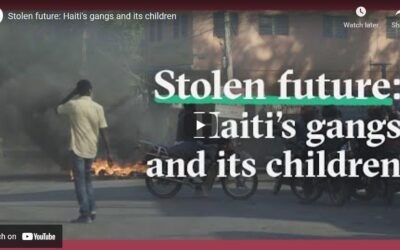Is the struggling country’s flamboyant President a savior or a rogue?
A few months ago, a crowd of curious onlookers gathered on a newly built highway overpass in downtown Port-au-Prince. It was a humid afternoon, too hot to linger outside, but Haiti’s President, Michel Martelly, was scheduled to appear, and any appearance by Martelly was bound to be entertaining. Before being elected President, in 2011, Martelly was Sweet Micky, an extroverted singer of the ebullient dance music called konpa. A popular and bawdy showman, he appears in one typical video clip in a night club, dancing for the camera in a red bra and a yellow sarong. At one point, he feigns masturbating a giant phallus, then hoists an imaginary breast and licks it.
At the overpass, jeeploads of riot police fanned out, and workmen set up a red carpet and a lectern with the Presidential seal on it. Martelly was coming to inaugurate the Delmas Viaduct, a four-lane bridge over a deep gully at the base of Delmas, a densely populated hillside neighborhood. As the crowd grew, a rara band, a squad of dreadlocked teen-agers, showed up to blow horns and beat drums. Martelly, who is fifty-four, arrived in a pink-and-white checked shirt worn untucked over black jeans. His shaved head gleaming, he cut a casually hip figure amid an entourage of plainclothes bodyguards and officials in suits. At the microphone, he spoke in guttural Creole, a French patois that is Haiti’s primary language. “This viaduct proves once again that together we can achieve great and beautiful things,” he said. “More than a dream, more than a project, this viaduct is now one of the symbols of Port-au-Prince.”
Martelly’s Presidency has been predicated on rebuilding. He took office a year after the January, 2010, earthquake that devastated Port-au-Prince, killing perhaps two hundred thousand people and leaving millions homeless. The disaster drew the world’s attention to Haiti’s long struggle—and, to some extent, offered a chance for a fresh start. In a survey of American voters, more than half reported donating to help repair the country; Bill Clinton, whose family foundation is deeply involved in Haiti, announced the hope that it could “build back better.” But Delmas, like much of Port-au-Prince, has been at best partly repaired. Even as the new overpass was unveiled, tens of thousands of residents were still displaced. As Martelly finishes his term in office, Haiti remains the poorest country in the Western Hemisphere. Some sixty per cent of its ten million citizens live in poverty. Nearly half are illiterate, and only one in four has access to a toilet.
Read the full New Yorker Article




0 Comments